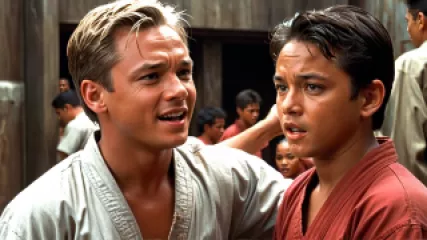Unlocking New Insights: Behavioral Therapy Techniques Inspired by Beloved Books and Films
Unlocking New Insights: Behavioral Therapy Techniques Inspired by Beloved Books and Films
Embracing Multimodal Learning: Lessons from the Silver Screen and the Printed Page
In the ever-evolving landscape of personal growth and self-improvement, we often find ourselves seeking innovative ways to unlock new perspectives and enhance our understanding of ourselves and the world around us. One particularly intriguing approach lies in the intersection of behavioral therapy techniques and the captivating narratives found in our favorite books and films. By drawing inspiration from these beloved sources, we can unlock a treasure trove of insights that can profoundly shape our learning styles and empower us to navigate life's challenges with greater ease and resilience.
Auditory Learning Meets "The Shawshank Redemption"
Consider the iconic film "The Shawshank Redemption," a poignant tale of friendship, resilience, and the power of the human spirit. At the heart of this story lies the character of Red, played masterfully by Morgan Freeman, whose soothing, well-modulated voice serves as a guiding light for the protagonist, Andy Dufresne, and the audience alike. For those with a pronounced auditory learning style, the captivating dialogue and narration in this film can serve as a powerful tool for personal growth and self-discovery.
As we immerse ourselves in the world of "The Shawshank Redemption," we can't help but be drawn in by the rich tapestry of sound, from the rhythmic tapping of a rock hammer against stone to the stirring orchestral score that underscores the characters' emotional journeys. By actively engaging with this sensory experience, auditory learners can unlock a deeper understanding of the themes and lessons woven throughout the narrative.
For instance, the scene where Red reflects on the power of hope, delivering the iconic line, "Hope is a dangerous thing. Hope can drive a man insane," can serve as a powerful meditation on the nature of resilience and the cultivation of a positive mindset. By repeatedly listening to and contemplating these words, auditory learners can internalize the message and apply it to their own lives, fostering a more nuanced understanding of the role of hope in personal growth and the management of emotional challenges.
Visual Learners and the Cinematic Splendor of "Life of Pi"
In contrast, the visually stunning film "Life of Pi" offers a captivating experience for those with a strong visual learning style. Directed by Ang Lee, the movie's breathtaking cinematography and vivid imagery transport the audience to a world of wonder and self-discovery, mirroring the protagonist's own transformative journey.
As we witness the vibrant colors of the ocean, the awe-inspiring sunsets, and the mesmerizing interactions between Pi and the Bengal tiger, Richard Parker, visual learners can find themselves deeply immersed in the narrative, absorbing the lessons and insights that unfold before their eyes. The film's masterful use of visual storytelling techniques, such as striking camera angles, evocative lighting, and meticulously crafted sets, can serve as a powerful catalyst for personal growth and the development of new perspectives.
For instance, the scene where Pi reflects on the nature of belief and the coexistence of different faiths, captured through the interplay of light and shadow, can resonate profoundly with visual learners, inspiring them to delve deeper into the complexities of spirituality and the search for meaning in life.
Kinesthetic Learning and the Embodied Experiences of "The Karate Kid"
While the aforementioned films cater to the auditory and visual learning styles, the classic film "The Karate Kid" offers a unique opportunity for kinesthetic learners to engage with the material on a physical and embodied level. In this heartwarming tale, the protagonist, Daniel LaRusso, learns the art of karate not through traditional classroom instruction, but through a series of seemingly mundane tasks and movements meticulously guided by his mentor, Mr. Miyagi.
As we witness Daniel's transformation from a scrawny, bullied teenager to a skilled and confident martial artist, kinesthetic learners can find themselves drawn to the tactile and sensory elements of the training process. The rhythmic movements of the "wax on, wax off" technique, the graceful dance-like forms, and the culminating climactic fight scene can all serve as powerful touchpoints for kinesthetic learners to internalize the lessons of discipline, perseverance, and the mind-body connection.
By emulating the physical movements and embodied experiences depicted in "The Karate Kid," kinesthetic learners can unlock deeper insights into the principles of behavioral therapy, such as the role of mindfulness, the power of visualization, and the importance of building a strong foundation of physical and mental resilience.
Unlocking the Multimodal Approach: Embracing the Richness of Combined Learning Styles
While the examples above highlight the potential of individual learning styles, the true power of behavioral therapy techniques inspired by beloved books and films lies in the embrace of a multimodal approach. By engaging with narratives that appeal to a diverse range of sensory experiences, we can unlock a more comprehensive understanding of ourselves and the world around us, ultimately leading to more lasting and impactful personal growth.
Consider the beloved novel "To Kill a Mockingbird" by Harper Lee. This timeless classic not only captivates readers with its rich, descriptive language (appealing to auditory learners) but also paints a vivid and evocative visual tapestry through its detailed character portraits and atmospheric settings (catering to visual learners). Moreover, the novel's exploration of complex social and moral issues, such as racial injustice and the preservation of innocence, invites readers to engage with the material on a deeper, more introspective level, fostering a sense of embodied learning and personal growth (appealing to kinesthetic learners).
By immersing ourselves in the multi-faceted narratives of "To Kill a Mockingbird," we can cultivate a more holistic understanding of the themes and lessons it presents, ultimately applying them to our own lives in a meaningful and impactful way. This approach not only enriches our personal development but also equips us with the tools to navigate the complexities of the human experience with greater empathy, resilience, and a nuanced perspective.
Embracing the Synergy of Behavioral Therapy and Storytelling
The synergy between behavioral therapy techniques and the power of storytelling extends far beyond the realm of film and literature. In fact, the integration of these two domains has given rise to innovative, evidence-based approaches to personal growth and healing.
One such example is the use of psychoeducational materials, which often blend the principles of behavioral therapy with engaging narratives and visual elements. These resources, such as self-help books, interactive workshops, and online courses, aim to educate individuals about the mechanics of human behavior, cognition, and emotion, while simultaneously fostering a sense of connection, empowerment, and practical application.
By weaving together the theoretical underpinnings of behavioral therapy with the captivating power of storytelling, these psychoeducational materials are able to reach a diverse audience, catering to a wide range of learning styles and personal preferences. The result is a transformative experience that not only imparts valuable knowledge but also inspires individuals to embark on a journey of self-discovery and positive change.
Embracing the Multimodal Approach: Strategies for Personal Growth
As we've explored, the integration of behavioral therapy techniques and the rich tapestry of storytelling can unlock a myriad of opportunities for personal growth and self-improvement. To fully embrace this multimodal approach, consider the following strategies:
1. Identify Your Primary Learning Style
Begin by reflecting on your own preferences and tendencies when it comes to processing information and engaging with new concepts. Are you primarily an auditory, visual, or kinesthetic learner? Understanding your dominant learning style can help you effectively curate and engage with the resources that will resonate most deeply with you.
2. Explore a Diverse Range of Narratives
Expand your horizons by immersing yourself in a variety of books, films, and other storytelling mediums that may not align with your primary learning style. Challenge yourself to step outside of your comfort zone and explore narratives that appeal to different sensory experiences. This cross-pollination of learning styles can lead to unexpected insights and a more holistic understanding of the material.
3. Engage in Multimodal Learning Experiences
Seek out educational and self-improvement resources that seamlessly integrate multiple learning modalities. Look for books that combine engaging visuals, thought-provoking text, and even audio narration. Attend workshops or online courses that blend interactive exercises, multimedia presentations, and opportunities for personal reflection and application.
4. Experiment with Embodied Learning
Incorporate physical, kinesthetic elements into your personal growth journey. This might involve practicing the mindfulness techniques depicted in your favorite films, or engaging in the embodied exercises inspired by beloved literary characters. By integrating the mind-body connection, you can unlock deeper insights and foster a more holistic approach to personal transformation.
5. Foster a Reflective Practice
Regularly set aside time to reflect on the lessons and insights you've gleaned from your exploration of behavioral therapy techniques and storytelling. Journal about your experiences, engage in thoughtful discussions with others, and actively seek opportunities to apply what you've learned to your daily life. This reflective practice will deepen your understanding and facilitate more sustainable personal growth.
Conclusion: Unlocking the Power of Multimodal Learning
As we embark on our journeys of self-discovery and personal growth, the integration of behavioral therapy techniques and the captivating power of storytelling offers a rich and multifaceted approach to unlocking new insights and transforming our lives. By embracing a multimodal learning style, we can tap into the diverse range of sensory experiences that resonate with us, ultimately fostering a deeper understanding of ourselves, our challenges, and our aspirations.
Whether we find ourselves captivated by the soothing voice of Morgan Freeman in "The Shawshank Redemption," mesmerized by the visual splendor of "Life of Pi," or moved by the embodied experiences of "The Karate Kid," the lessons and insights we glean from these beloved narratives can serve as powerful tools for personal growth and the cultivation of a more resilient, empowered, and authentic self.
So, let us embrace the synergy between behavioral therapy and storytelling, and embark on a journey of multimodal learning and self-discovery. For in doing so, we just may unlock the key to unlocking our full potential and living life to the fullest.






